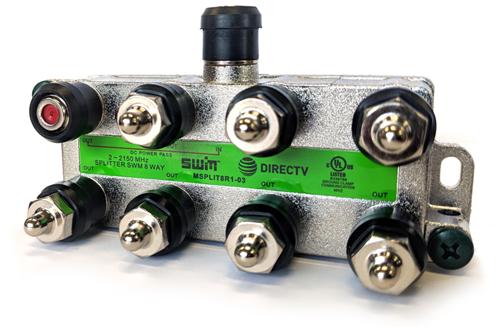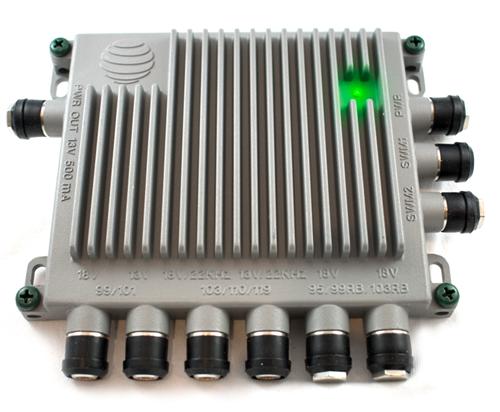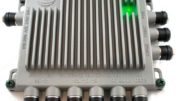This is DIRECTV’s 8-way splitter.

One port in, eight ports out. So, here’s an easy question: How many DIRECTV HR24 DVRs can you connect to it? Sounds like an easy question, right? Should have an easy answer. And, you know what, it does. The answer is… six.
Six? What?
This is the kind of thing that will send you screaming if you don’t understand the logic behind it. It really comes down to three things: understanding DIRECTV’s SWM technology, understanding how splitters work, and understanding how DIRECTV DVRs work. That should be easy, right? I should be able to give you all of that in 500 words, right? Well, let’s try anyway. Hopefully I can give you a little bit of understanding of the whole thing, enough that you won’t go sideways when you try to upgrade your DIRECTV system.
First, let’s understand DVRs.
Modern DVRs have been with us for about 25 years. DIRECTV has been offering them for 20 of those years. It’s very established technology, and while that doesn’t automatically make it easy to explain, it does help a little bit. The obvious role of a DVR, a digital video recorder that is, is to record digital video. It’s right in the name. But even from the very start, no one wanted to just record one thing at a time. Before DVRs we used video tape. VCRs always had a switch that let you watch one thing while recording another. (Sometimes it didn’t work, but that’s a story for another article.) So, even the earliest DVRs had this sort of thing too. Not only did they let you watch one thing and record another, they actually let you record two things at the same time.
Doing this meant that the box technically wasn’t really one DVR, but two. Most DVRs prior to the 2010s had two sets of tuners in them. Each one could function independently. Later, devices like DIRECTV’s Genie and DISH’s Hopper expanded this to 5, 7, 13, and 16 tuners at a time. But that’s not super important right now. We’re talking about DIRECTV’s HR24, which still lets you record two things at once and no more. It will help for the next part of the discussion to think of it as two DVRs in one box, because it kind of is.
Now let’s talk about DIRECTV SWM technology.
In the earliest systems, you needed one wire in for every tuner in the box. In other words, a 2-tuner DVR like the HR24 would need 2 wires into it. This wouldn’t work for modern DVRs, as you’d need a lot of wires into the thing. It was expensive to wire things that way and it was a lot of holes in the wall. Something needed to be done.
The answer was DIRECTV’s Single-Wire Multiswitch technology, which we refer to as SWM. SWM uses some complex magic which I won’t go into too much here. What you need to know is that most SWM multiswitches today can accept one of six kinds of signals. They can then put them all together so they travel on one line. (Sometimes the multiswitch is built into the dish, so you only ever see one line.)

For those folks who don’t have the tech built into the dish, you use something like this SWM-30 multiswitch. As I said, it takes six lines in, and provides two lines out. Each of those two lines can carry all six signals at the same time. But, there is a limitation. They can only support 15 devices on each wire. This has to do with the fancy magic that it takes to put the contents of 6 wires onto one wires. Why 15? It’s a long story, but it has to do with the amount of bandwidth on the wire that’s actually usable for this purpose. 15 devices can be supported by that amount of bandwidth, simple as that.
So remember how I told you how it’s almost better to think of the HR24 as two DVRs stuck into one box? This is why. The SWM30 can support 13 devices on each output, but if your DVR has two tuners it counts as two devices. So, really the SWM30 can’t support 15 DVRs. In fact, because of a quirk in the HR24 itself it can’t even support 7 (divide 15 by 2, you get 7.5 and you can’t have half a DVR). The maximum number of HR24s supported on each output of a SWM is 6. There’s a lot of background as to why it’s 6 and not 7 but I’m trying to keep this pretty short.
And then let’s talk splitters.
DIRECTV makes 2, 4, and 8 port splitters. They don’t make 3 or 6 port splitters. There are two reasons for this. The first is just plain cost cutting. You could use an 8-port splitter to connect 8 receivers, and you can use it to connect 6 HR24s, with two empty ports. It doesn’t make any difference, so why have two devices?
If you know anything about the way that signal flow works, you know that the more times you split a signal, the weaker it gets. So it would seem like if you had a 6-port splitter, it would be better than an 8-port splitter. Except for one thing… there really isn’t such a thing as a 6-port splitter.
It’s very difficult to split a signal into 3 equal parts. It takes a lot of componentry that introduces a lot of cost and signal loss by itself. On the other hand, it’s pretty darn easy to split a signal into 2, 4, or 8 equal parts. So while there are 3-port and 6-port splitters out there for some equipment, they’re usually 4-port and 8-port splitters where the extra ports are hidden from you. Because of that, there’s really no benefit to having a 6-port splitter as opposed to an 8-port one.
So let’s tie this up in a little bow.
Each output of a SWM multiswitch can support 6 HR24s, because each HR24 has two tuners in it rather than just one. An 8-port splitter and a 6-port splitter are essentially the same thing. So, there’s the answer. This only leaves one question:
What happens if you put more than 6 HR24s on one splitter?
You’ll get errors that move around from DVR to DVR. The DVRs may seem fine at first and may even work for a good long time as long as you’re not actively using all of them at the same time. But, eventually, an error will pop up and it will affect your entire satellite TV system. And folks, that’s the last thing you want. You don’t want to worry about rewiring everything just because you want to watch TV.
That’s where the folks at Solid Signal can help. This little tutorial is just the beginning of the story. Our techs are ready to give you all the information you need to build the entertainment system of your dreams. Whether you’re at home, at work, in an RV or even out on the water, we have satellite TV solutions that will give you the exact solution you’re seeking.
Call the experts at 888-233-7563. We’re here during East Coast business hours. If it’s after hours, fill out the form below and we will get right back to you!





